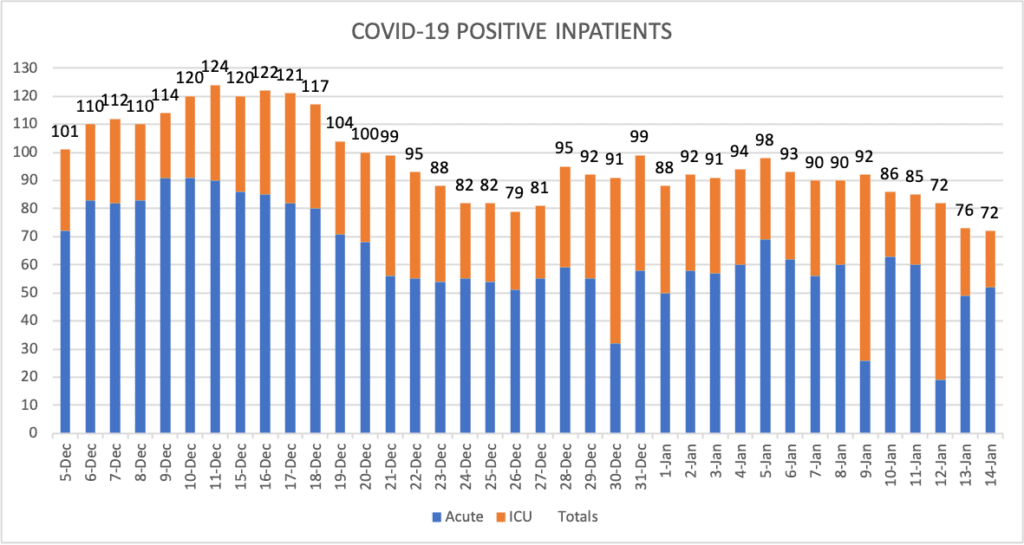Data Snapshot
UW Medicine Hospitals:

King County: The county reported 572 new positive cases and 3 new deaths on Jan. 13.
Washington: The state reported 269,201 cases and 3,838 deaths as of Jan. 12.
United States: The CDC reports 22,740,142 cases and 379,255 deaths as of Jan. 13.
Global: WHO reports 90,759,370 confirmed COVID-19 cases and 1,963,169 deaths as of Jan. 14.
*Numbers update frequently, please follow links for most up-to-date numbers.
UW Medicine COVID-19 Vaccine Distribution Update
Total Vaccinated: 22,839
· Employees: 15,925
· Community Members: 6,914
COVID-19 Literature Report
COVID-19 Literature Situation Report is a daily (M-F) newsletter put together by the Alliance for Pandemic Preparedness that provides a succinct summary of the latest scientific literature related to the COVID-19 pandemic.
Key Takeaways: COVID-19 Literature Situation Report Jan. 12, 2021
- Rates of pediatric hospitalization for COVID-19 varied considerably across states from May to November 2020. In May, rates ranged from 0 per 100,000 (HI and RI) to 5.4 per 100,000 (NJ) and in November ranged from 3.4 per 100,000 (NH) to 32.8 per 100,000 (AZ). Some states experienced a rapid increase in rates, with Utah experiencing a 5,067% increase (from 0.3 to 15.5 per 100,000) within 3 months. More.
- Among 130 symptomatic COVID-19 cases in London (July and September 2020), 32% attended the workplace after symptom onset. Men were less likely than women to attend the workplace after onset of COVID-19 symptoms. Age and occupation were not associated with workplace attendance after symptom onset. More.
- Modeling indicates that that bi-directional contact tracing could reduce the effective reproductive number for SARS-CoV-2 transmission by 2-fold compared to conventional forward-tracing alone. Bi-directional contact tracing identifies potential infectors of known cases, which could lead to identification of additional cases arising from the potential infectors. More.
COVID-19 Literature Surveillance Team, is an affiliated group of medical students, PhDs and physicians keeping up with the latest research on SARS-CoV-2 / COVID-19 by finding the newest articles, reading them, grading their level of evidence and bringing you the bottom line.
Read the latest report: Jan. 12 | Daily COVID-19 LST Report.
Listen to the latest podcast: Jan. 5 | COVID-19 LST Podcast.
UW Medicine in the News
NPR: U.K. Variant Could Drive A New Surge In The U.S., Experts Warn
Featuring: Trevor Bedford, Genome Sciences
‘“Now scientists say the virus is already here in the U.S., and circulating widely– albeit at very low levels, says computational biologist Trevor Bedford at the Fred Hutchinson Cancer Research Center [and Department of Genome Sciences at UW School of Medicine]. ‘A rough estimate, for across the U.S., would be a frequency of about 1 in 1000,’ he told NPR last week. ‘So about 1 in every 1000 COVID infection is due to the variant.’ Bedford expects that percentage to rise quickly. In England, B.1.1.7 took about three month to take over and become the dominant strain in the outbreak. Scientists believed the variant first emerged in September. By December, it had become the dominant version in London. ‘So I roughly expect a similar timeline of three months, from the variant’s initial arrival in the U.S. in December to starting to dominate the virus population around March,’ Bedford said.”’
The Wall Street Journal: Can you still spread COVID-19 after you get vaccinated?
Featuring: Marion Pepper, Immunology
“Do the Covid vaccines prevent you from spreading the virus, or do they just protect you from getting sick? Scientists don’t know yet—and the uncertainty has big implications during the rollout of the vaccines. Pfizer and Moderna, the companies that developed the vaccines authorized in the U.S. so far, say their vaccines are about 95% effective at preventing people from getting sick with Covid symptoms. But there’s not enough evidence yet on whether the vaccines also prevent asymptomatic infection and transmission. The companies say research is ongoing to determine the answer. Without vaccines, research has suggested that asymptomatic transmission of the coronavirus that causes Covid is responsible for roughly a quarter of infections. The result, experts say, is that precautions like wearing masks, social distancing and avoiding crowded spaces will be necessary until the country gets closer to herd immunity, the point at which enough people are immune to a disease to make its spread unlikely. Some studies have estimated roughly 75% to 80% of the U.S. population needs to be immune to Covid-19 to reach herd immunity, but that number is a moving target and could rise as new variants emerge. ‘Everyone needs to keep wearing masks and we all need to do our part in reducing the transmission so it’s not going to be as difficult to control,’ says Marion Pepper, an immunologist and associate professor at the University of Washington in Seattle. ‘This is really important.’”
Scientific American: COVID Is on Track to Become the U.S.’s Leading Cause of Death—Yet Again
Featuring: IHME
‘“The Institute for Health Metrics and Evaluation at the University of Washington projects that by April 1 this year, COVID-19 may be responsible for the deaths of more than 560,000 people in the U.S.—a figure that represents 84 percent of the total number of people who died in the country during the 1918 flu pandemic. A recent Viewpoint piece in JAMA repeats a common mantra of how the U.S. must respond. ‘The prospect of a vaccine offers hope for 2021, but that solution will not come soon enough to avoid catastrophic increases in COVID-19–related hospitalizations and deaths,’ the article notes. ‘The need for the entire population to take the disease seriously—notably to wear masks and maintain social distance—could not be more urgent.”’
Tweet of the Week
Volunteers are sought for a "pivotal" trial to determine the efficacy & safety of the Novavax #vaccine candidate. @thedaily https://t.co/NZfc5dnK8K #COVID19
— UW Medicine Newsroom (@uwmnewsroom) January 13, 2021

